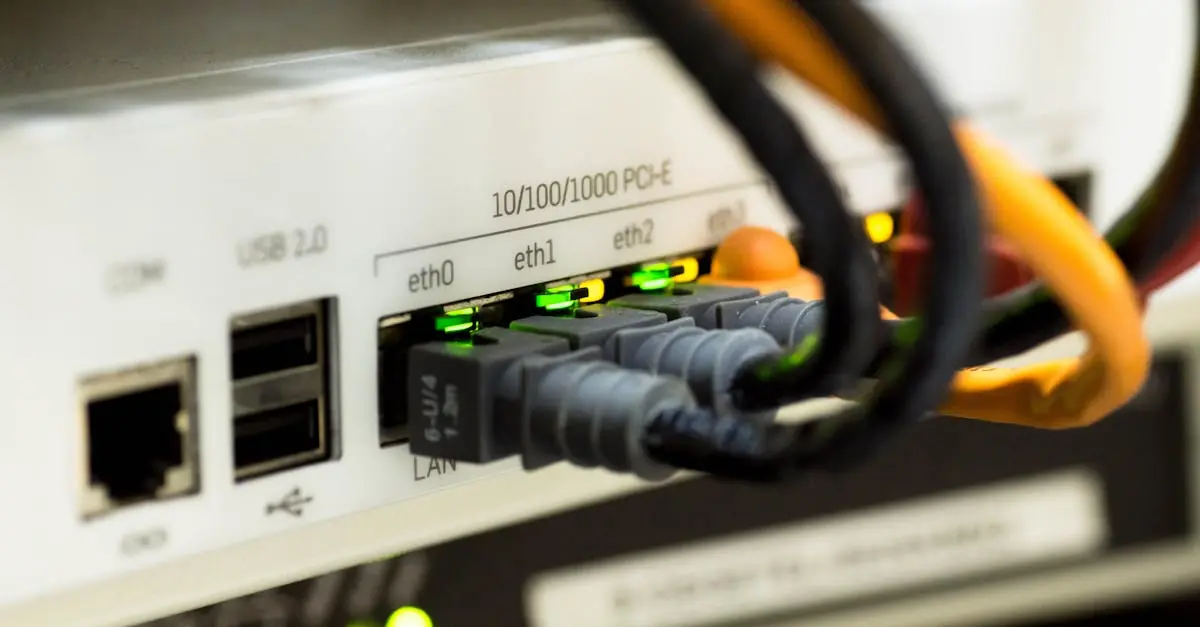In a world where smart devices are taking over homes faster than you can say “Wi-Fi,” setting up an IoT VLAN might seem like a daunting task. But fear not! This guide is here to turn that techy maze into a walk in the park. Imagine a digital playground where all your devices can frolic freely without stepping on each other’s toes. Sounds delightful, right?
By isolating your Internet of Things gadgets into their own virtual LAN, you not only enhance security but also improve performance. Think of it as giving your smart fridge its own VIP section at the party—no more awkward encounters with the toaster! With a sprinkle of humor and a dash of professionalism, this article will help you navigate the ins and outs of IoT VLAN setup, ensuring your smart home runs smoother than a freshly updated app.
Table of Contents
ToggleOverview of IoT VLAN Setup
Setting up an IoT VLAN involves creating a dedicated network for smart devices. This network segregates these devices from other elements of the home network, significantly enhancing security and performance. Each smart gadget operates without interference from more bandwidth-heavy devices like computers or gaming consoles.
First, assess the number and types of IoT devices in the home. Common examples include smart thermostats, cameras, and lights. Identifying these devices helps in defining the VLAN’s scope.
Next, configure the router settings to create the VLAN. This process involves accessing the router interface and selecting the option to set up a new VLAN. Assign a unique VLAN ID, which distinguishes this network from others.
After establishing the VLAN, it’s essential to configure IP addresses for the IoT devices. Static IP addresses offer stability, allowing devices to communicate effectively. Dynamic addressing can also be used, but it may lead to fluctuations in connectivity.
Implementing security measures is crucial in this setup. It’s advisable to use strong passwords and enable encryption to prevent unauthorized access. Firewalls can also help monitor incoming and outgoing traffic within the VLAN.
Testing the setup is the final step. Verify the connectivity of each IoT device and ensure they communicate efficiently within the VLAN. Routine checks can help maintain the network’s performance over time.
An effective IoT VLAN setup requires thoughtful planning and execution, focusing on isolation, security, and ongoing management.
Benefits of IoT VLAN Setup
Setting up an IoT VLAN brings several advantages that enhance the functionality and security of smart homes. Two key benefits include enhanced security and improved network performance.
Enhanced Security
Isolating IoT devices within a VLAN reduces the risk of unauthorized access. Each smart device operates in its own segment, making it difficult for hackers to infiltrate the entire network. Strong security measures become easier to implement, as routers can enforce specific firewall rules for IoT traffic. Intrusion detection systems can focus on monitoring this segmented traffic separately, enhancing overall safety. Regular firmware updates for IoT devices bolster security further, ensuring vulnerabilities are patched promptly. Ultimately, this strategic segregation creates a robust defense against potential cyber threats.
Improved Network Performance
Performance issues often arise when numerous devices compete for bandwidth. A dedicated IoT VLAN alleviates these problems, allowing smart devices to communicate without interference from heavy bandwidth users like PCs or gaming consoles. Each device receives more stable and prioritized network resources, leading to quicker response times. Quality of service settings further optimize the network, enhancing the speed of critical IoT functions like smart lighting or home security systems. Overall, this structured setup promotes an efficient, seamless interaction among devices while maintaining high-speed connectivity.
Steps to Configure IoT VLAN Setup
Configuring an IoT VLAN involves several key steps aimed at optimizing network performance and security. Each phase requires attention to detail for effective implementation.
Assessing Network Requirements
Identifying the number and types of IoT devices is essential. List devices such as cameras, smart speakers, and thermostats to understand bandwidth needs. Analyze existing network traffic patterns to determine potential bottlenecks. Consider future device additions as well, anticipating growth. Establish a clear understanding of how these devices communicate will streamline the VLAN setup process.
Setting Up VLANs on the Switch
Creating VLANs on the switch requires accessing the switch’s management interface. Use a web browser or command line to log in to the switch’s configuration. Define VLANs by assigning unique IDs to each, which simplifies the isolation of IoT devices. Label VLANs descriptively to reflect their designated purposes. Implement changes and save the configuration to ensure settings persist through reboots.
Configuring Access Ports and Trunk Ports
Configuring access ports involves designating specific ports for IoT devices within the VLAN. Assign each IoT device’s port to the corresponding VLAN ID to maintain network organization. Trunk ports, on the other hand, facilitate the transfer of traffic between VLANs. Set these ports with tagging protocols such as 802.1Q to allow multiple VLANs’ traffic through a single physical link. Document all configurations carefully for future reference and troubleshooting.
Common Challenges in IoT VLAN Setup
Setting up an IoT VLAN can present several challenges. Addressing these issues ensures optimal functionality and security for smart devices.
Compatibility Issues
Devices designed for the Internet of Things exhibit a wide range of specifications. Incompatibilities arise when older devices lack support for newer VLAN standards. Ensuring that all devices can integrate smoothly is crucial for a functional network. Adding different types of IoT devices may complicate the VLAN configuration process. Each device may require specific settings or features, making it difficult to achieve seamless communication. Manufacturers often focus on Wi-Fi standards, leading to potential clashes between devices and the router or switch configurations.
Management Complexity
Managing an IoT VLAN involves intricate configurations and ongoing maintenance. It requires an understanding of network protocols and VLAN tagging. Each device must be assigned correct VLAN IDs, which adds layers of complexity. Regular monitoring and troubleshooting become essential, especially as new devices connect to the network. Network admins often face difficulties in managing device updates and security revisions in a segmented environment. Collaborating with various tools can streamline management, but navigating between different platforms may pose challenges. Prioritizing simplicity and reliability plays a vital role in optimizing the overall network performance.
Setting up an IoT VLAN transforms a smart home into a secure and efficient environment. By isolating devices within their own network space users can enjoy enhanced security and improved performance. This dedicated approach not only minimizes interference from bandwidth-heavy applications but also establishes a robust defense against potential cyber threats.
As technology evolves and new devices emerge regular monitoring and maintenance of the VLAN will ensure continued functionality and security. Embracing this setup allows users to manage their smart devices effectively while enjoying the peace of mind that comes with a well-structured network. A thoughtful IoT VLAN configuration is a vital step toward a smarter and safer home.





